one more Piranesian daze: circus act
2000.05.15
In attempting to discern the possible reason or message manifested by the plan changes to the Circus of Caligula and Nero and to the Circus Agonalia, I began to think of these specific circuses and how they may or may not relate to the numerous other circuses delineated throughout the Ichnographia. Within the version of the Ichnographia that is presently widely published there are six circuses, the Circus Caji et Neronis, the Circus Agonalia, the Circus Hadriani, the Circus Domtiae, the Circus Flaminius, and the Circus Apollinaris. With only minor adjustments to length, each circus is delineated in a virtually identical fashion, and, moreover, each circus reflects an archaeologically correct circus plan. As already illustrated, the plans of the Circus Caji et Neronis and the Circus Agonalia within the University of Pennsylvania Ichnographia reflect more stylized, i.e., archaeologically incorrect, circus formations. Since all the circuses are identical in the widely published version of the Ichnographia, I then began to wonder, via transposition, whether all the circuses within the Penn Ichnographia were likewise identical there in the form of exhibiting plan changes. In all honestly, I had not noticed any plan changes to the circuses other than the Circus Caji et Neronis and the Circus Agonalia the two times I had seen the Penn Ichnographia prior, but nor did I have any pictorial hardcopy evidence that there are no other plan changes. Having worked with the Ichnographia for over ten years, if I have learned anything, it is that the Ichnographia, no matter how well you think you know it, continually maintains the uncanny ability to beguile. Therefore, it was necessary for me to once more return to the other Ichnographia.
Upon doing further research, i.e., going back to the University of Pennsylvania's Fine Arts Library to again scan the Ichnographia Campus Martius, more plan changes were indeed discovered, and, just as I had begun to suspect, the "change of plans" effected the Circus Hadriani, the Circus Domitiae, the Circus Flaminius, and the Circus Apollinaris. Thus, it is now evident that each of the major "changes of plan", between the Ichnographia Campus Martius that is widely published and the Ichnographia Campus Martius within the rare book collection at the University of Pennsylvania's Fine Arts Library, occur more or less exclusively within those buildings of the Ichnographia labeled "circus".
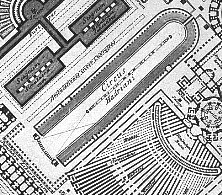 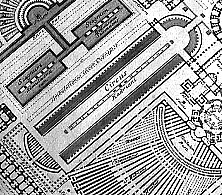
The plan above left is the Circus Hadriani as it appears within the commonly reproduced Ichnographia. Above right is the Circus Hardiani as it appears within the Ichnographia at the University of Pennsylvania.
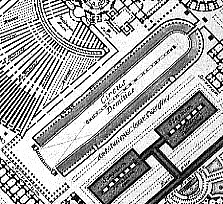 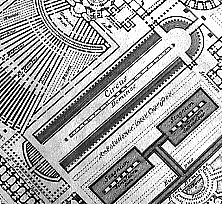
The plan above left is the Circus Domitiae as it appears within the commonly reproduced Ichnographia. Above right is the Circus Domitiae as it appears within the Ichnographia at the University of Pennsylvania.
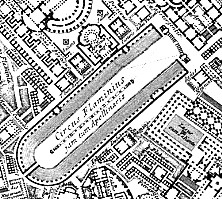 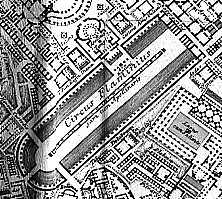
The plan above left is the Circus Flaminius as it appears within the commonly reproduced Ichnographia. Above right is the Circus Flaminius as it appears within the Ichnographia at the University of Pennsylvania.
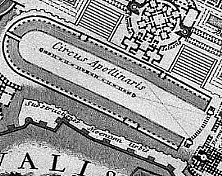 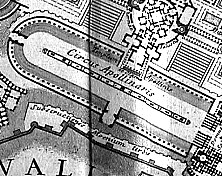
The plan above left is the Circus Apollinaris as it appears within the commonly reproduced Ichnographia. Above right is the Circus Apollinaris as it appears within the Ichnographia at the University of Pennsylvania.
As the above plan comparisons indicate, the newly discovered circus plans engage directly with their neighboring buildings, thereby rendering a connected contextualism and demonstrating a more integrated urban planning methodology. The circus plans of the commonly reproduced Ichnographia on the other hand, albeit archaeologically correct, do not engage their immediate surroundings, and appear as though literally afterthoughts. Beside the already mentioned questions as to what these changes might mean and which set of plans came first, or what Piranesi's intentions in making the changes might have been, there is now an additional question as to why the changes were specifically and only applied to the Campo Marzio's six circuses.
a change of plan
2000.12.26
Re: 'game over' design
2002.05.12 19:59
I got a copy of Homo Ludens a few years ago, and so far I have really only read the introduction. Nonetheless, I still got much from the book so far. For example, I collected many passages that I feel relate to how Piranesi designed / 'played with' his reenactment of ancient Rome via the Ichnographia Campi Martii--indeed, reenactment itself is very much a "re-play", literally a playing / acting [even designing?] again.
I also most remember how Huizinga describes the role of the 'spoil sport', i.e., the one that doesn't want to play by the rules as most of the others have established them. Huizinga more than just hints that many times the contrariness of the 'spoil sport' in time becomes the newest set of rules--Piranesi also played a very sophisticated inversion game in his literal delineation of the Campo Marzio.
| |
Re: what a difference 250 years make
2002.11.24 17:48
You're kind of exactly right when you suggest that maybe there are too many places of "historic" significance in Philadelphia, and it is interesting that you bring to mind Piranesi and his map of the Campo Marzio because that map/plan indeed records so many of ancient Rome's historic sites even though almost none of them still existed in Piranesi's time. Moreover, it is worth also keeping in mind that Piranesi was delineating a place/city more than 1400 years after the fact. It seems almost impossible to even speculate whether, for example, the old "Indian" trail of Ridge Avenue will even still exist in 3402. Then again, it would be fun to imagine what some future Philadelphia Renaissance or Baroque period might be like. Note Franklin and Piranesi are near contemporaries; Piranesi died 1778 while Franklin was in France.
Re: Favorite Artist?
2003.01.24 15:27
I favor Piranesi because he treated historiography as art, the same way he treated archaeology as art. What he did came right before the distinct rise of science, and it's separation from 'art'.
REPORTAGE- Rhythm & Gender
2004.05.18 10:26
Why do you think Piranesi first deliniated all the circuses of the first printing of the Ichnographia Campus Martius in a stylized manner, and then (unnoticed for over 200 years) changed all the circuses into copies of the Circus of Maxentius in the second printing of the Ichnographia Campus Martiis? Piranesi sure knew how to paint a quaestio abstrusa!
Fantasy Architecture?....
2004.12.16 11:36
Piranesi's Ichnographia Campus Martius is not really about fantasy, rather it is a reenactment of ancient Rome's history delineated via ancient Rome's architecture. The plans with their Latin labels within the large plan are all texts that together deliver the history of the city of Rome. Piranesi did a fantastic job of making a history lesson appear as fantasy.
Re: Ichnographia Romaphilia
2004.12.16 13:56
While working with Piranesi the discussion is often enlightening.
"So why exactly did you produce two versions of the Ichnographia Campus Martius and keep everyone none the wiser?"
"Overall, I just wanted to see who would find the two versions first. They were found, eventually (after more than two hundred years), but it's embarrassing for all the Piranesi "scholars" because it wasn't one of them."
"Why do you think the so-called scholars failed? Why did they not see what was always right in front of them?
"Simply put, they never reenacted the source."
"Kahn reenacted the source, and he didn't see the two versions."
"Well, I'd say Kahn was busy manifesting new versions of his own."
"Perhaps it's just plain destiny that Philadelphia itself reenacts the source."
"You know, I love you guys like brothers."
"That's fine as long as you realize that we're all independent as well."
"Ha, tell that to Romulus and Remus."
...and Piranesi
2005.04.17 14:47
Piranesi did a whole lot more than visually represent "improbable and imagined" spaces. Piranesi was primarily an ur-archaeologist, and his hands-on understanding of "history" manifests an unprecedented delineation of how history coalesces with (architectural) design. Even Piranesi's personal design history manifests a coalescence, e.g., Prima Parti di Architetture e Prospettive through the Carceri through the Osservazioni sopra la Lettre de M. Mariette through the Diverse Maniere d'Adornare i Cammini through the Vasi, Candelabri, Cippi.
...remember when you responded with:
"Xavier Costa, in a class he taught at the AA while I was there, related it [the Ichnographia Campi Martii] to museological strategies/memory aids. Not sure that this is what you are asking, and I don't know if he ever published such a thing."
Could it be that Costa received his information from Marcel Baumgartner's "Topographie als Medium der Erinnerung in Piranesi's 'Campo Marzio dell' Antica Roma'"? published in 2000? Baumgartner at least admits/footnotes his knowledge of the Encyclopedia Ichnographica as published at www.quondam.com from 1 July 1998 to 20 March 2000.
Krautheimer and Johnson
2005.07.07 15:23
It just never occurred to him before that the Mausoleum of Romulus/Circus of Maxentius complex (which reenacts the almost two hundred years earlier Mausoleum of Hadrian/Circus of Hadrian complex) became the paradigm, albeit inverted, for all the Roman Christian "church" architecture immediately after the Basilica Constantiniani (St. John Lateran) and the Basilica San Pietro Vaticano. That aerial shot of the Mausoleum of Constantina (Santa Costanza) adjacent the circus-like dining hall first "basilica" of St. Agnes made it all so clear. If only the circus-like dining hall first "basilica" of Sts. Pietro and Marcellinus adjacent the Mausoleum of Helena were still to be seen from the air. How clever of Eutropia and Helena to invert the pagan 'munus' architecture into Christian 'munus' architecture, and how very clever of Piranesi to secretly hide all this architectural history information within the ever quaestio abstrusa Ichnographia Campi Martii.
"How Did This Happen Revisited"
2005.08.08 15:58
Last Friday I read about Vitruvius Britannicus in Architectural Theory: from the Renaissance to the Present (Taschen, 2003) and was surprised to learn:
"For Campbell St. Peter's is by no means merely an especially striking expression of architectural abuses on the Continent: it also stands for Italy's cultural decline. As such he emphasizes in his foreword that in the post-Palladian era Italy had not only become estranged from the true "taste of building," but also from the roots of its culture, the Latin language. From this perspective, Italy could no longer be the destination of the Grand Tour. Campbell considers such understandings to be "Mistakes in Education." As the Vitruvius Britannicus is intended to demonstrate, it is now the architects and artists of England who are to take Italy's place as the preservers of timeless, classical taste."
I cannot recall having ever read that Piranesi's [mid-life] oeuvre is in some ways a reaction to Vitruvius Britannicus, but I certainly see [that it coluld be] that way now.
It rocked Eisenman in his chair...
2005.11.10 15:03
To be honest, I care very little about what Bloomer wrote or how she intellectually operates. What I do care about is what Piranesi delineated via the two versions of the Ichnographia of Il Campo Marzio.... All I have ever done is analyze the Ichnographia itself, which is exactly what virtually all other contemporary writers on the Ichnographia have not done! I have never been interested in spreading some current/trendy intellectual "thought" by troping Piranesi and the Ichnographia, a course of action begun by Tafuri. What I am interested in is to find out what Piranesi did himself.
|